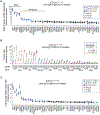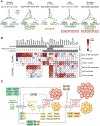A Functional Taxonomy of Tumor Suppression in Oncogenic KRAS-Driven Lung Cancer
- PMID: 33608386
- PMCID: PMC8292166
- DOI: 10.1158/2159-8290.CD-20-1325
A Functional Taxonomy of Tumor Suppression in Oncogenic KRAS-Driven Lung Cancer
Abstract
Cancer genotyping has identified a large number of putative tumor suppressor genes. Carcinogenesis is a multistep process, but the importance and specific roles of many of these genes during tumor initiation, growth, and progression remain unknown. Here we use a multiplexed mouse model of oncogenic KRAS-driven lung cancer to quantify the impact of 48 known and putative tumor suppressor genes on diverse aspects of carcinogenesis at an unprecedented scale and resolution. We uncover many previously understudied functional tumor suppressors that constrain cancer in vivo. Inactivation of some genes substantially increased growth, whereas the inactivation of others increases tumor initiation and/or the emergence of exceptionally large tumors. These functional in vivo analyses revealed an unexpectedly complex landscape of tumor suppression that has implications for understanding cancer evolution, interpreting clinical cancer genome sequencing data, and directing approaches to limit tumor initiation and progression. SIGNIFICANCE: Our high-throughput and high-resolution analysis of tumor suppression uncovered novel genetic determinants of oncogenic KRAS-driven lung cancer initiation, overall growth, and exceptional growth. This taxonomy is consistent with changing constraints during the life history of cancer and highlights the value of quantitative in vivo genetic analyses in autochthonous cancer models.This article is highlighted in the In This Issue feature, p. 1601.
©2021 American Association for Cancer Research.
Conflict of interest statement
CONFLICT OF INTERESTS
S.K.C. receives grant support from Ono Pharma. C.S. acknowledges grant support from Pfizer, AstraZeneca, Bristol Myers Squibb, Roche-Ventana, Boehringer-Ingelheim, Archer Dx Inc (collaboration in minimal residual disease sequencing technologies) and Ono Pharmaceuticals. C.S is an AstraZeneca Advisory Board member and Chief Investigator for the MeRmaiD1 clinical trial, has consulted for Pfizer, Novartis, GlaxoSmithKline, MSD, Bristol Myers Squibb, Celgene, AstraZeneca, Illumina, Amgen, Genentech, Roche-Ventana, GRAIL, Medicxi, Bicycle Therapeutics, and the Sarah Cannon Research Institute, has stock options in Apogen Biotechnologies, Epic Bioscience, GRAIL, and has stock options and is co-founder of Achilles Therapeutics. D.A.P. and M.M.W. are founders of, and hold equity in, D2G Oncology Inc.
Figures







References
-
- Consortium APG. AACR Project GENIE: Powering Precision Medicine through an International Consortium. Cancer Discov 2017;7(8):818–31 doi 10.1158/2159-8290.CD-17-0151. - DOI - PMC - PubMed
Publication types
MeSH terms
Substances
Grants and funding
- T32 CA009302/CA/NCI NIH HHS/United States
- 30025/CRUK_/Cancer Research UK/United Kingdom
- R01 CA207133/CA/NCI NIH HHS/United States
- FC001169 /WT_/Wellcome Trust/United Kingdom
- T32 HG000044/HG/NHGRI NIH HHS/United States
- R35 GM118165/GM/NIGMS NIH HHS/United States
- F32 CA236311/CA/NCI NIH HHS/United States
- P30 CA124435/CA/NCI NIH HHS/United States
- R01 CA230919/CA/NCI NIH HHS/United States
- R01 CA231253/CA/NCI NIH HHS/United States
- 20466/CRUK_/Cancer Research UK/United Kingdom
- 25253/CRUK_/Cancer Research UK/United Kingdom
- FC001169 /CRUK_/Cancer Research UK/United Kingdom
- FC001169 /MRC_/Medical Research Council/United Kingdom
- K99 CA226506/CA/NCI NIH HHS/United States
- 17786/CRUK_/Cancer Research UK/United Kingdom
- R00 CA226506/CA/NCI NIH HHS/United States
- R35 HG011316/HG/NHGRI NIH HHS/United States
- R01 CA234349/CA/NCI NIH HHS/United States
- FC001169/WT_/Wellcome Trust/United Kingdom
LinkOut - more resources
Full Text Sources
Other Literature Sources
Medical
Molecular Biology Databases
Research Materials
Miscellaneous

